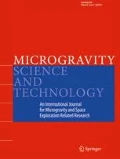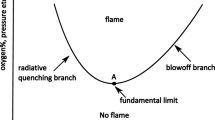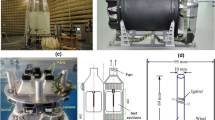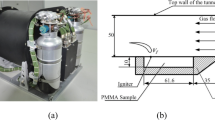Abstract
A series of experiments were conducted in the 3.6-s microgravity drop tower and normal gravity to investigate the effect of solid fuel curvature, conduction, and reradiation on the flame extinction of spherical polymethyl methacrylate (PMMA). In the semi-quiescent microgravity environment, flame extinction was observed if the PMMA diameter was larger than 40 mm, because of a smaller flame conductive heating in larger diameter (i.e., the curvature effect). Compared to the droplet combustion with a low evaporation point and fast heat convection in the liquid phase, the solid fuel has a high pyrolysis point and large transient heat conduction. Thus, the large surface reradiation effectively cools down the fuel surface to promote extinction. Also, as the initial burning duration increases, the conductive cooling into the solid fuel decreases, which delays or prevents the flame extinction in microgravity. The extinction criterion for microgravity flame is explained by the critical mass flux and mass-transfer number. This work helps to understand the curvature effect of solid fuel on flame extinction and the material fire safety in the microgravity spacecraft environment.








Similar content being viewed by others
Abbreviations
- A :
-
area (mm2)
- B :
-
mass-transfer number (−).
- c g :
-
specific heat of gas (J/kg/K).
- c p :
-
specific heat of solid (J/kg/K).
- d :
-
diameter (mm).
- d eq :
-
equivalent diameter (mm).
- FSR :
-
flame stand-off ratio (df/ds).
- Δhc :
-
heat combustion (J/kg).
- Δhpy :
-
enthalpy of pyrolysis (J/kg).
- L :
-
characteristic length (mm).
- m :
-
mass (g).
- \( {\overset{\cdot }{m}}^{{\prime\prime} } \) :
-
mass flux (g/m2/s).
- k :
-
heat conductivity (W/m-K).
- \( {\overset{\cdot }{q}}^{{\prime\prime} } \) :
-
conductive heat flux (kW/m2).
- r :
-
sphere radius (mm).
- t :
-
time (s).
- t 0 :
-
initial burning duration (s).
- T :
-
temperature (K).
- V :
-
Volume (mm3)
- X r :
-
fraction of flame radiation (−).
- \( {Y}_{{\mathrm{O}}_2} \) :
-
mass fraction of oxygen (−).
- δ :
-
depth (mm).
- ε :
-
radiative emittance (−).
- η :
-
ratio coefficient (−)
- κ :
-
fuel curvature, 1/r (mm−1).
- υ :
-
air to fuel stoichiometric mass ratio.
- ρ :
-
density (kg/m3).
- σ :
-
Stefan-Boltzmann constant (W/m2/K4).
- Φ:
-
thermocouple diameter (mm).
- ∞:
-
ambient.
- cond:
-
conduction.
- crt:
-
critical value
- f :
-
flame.
- in :
-
in-depth net net heat flux
- py :
-
pyrolysis.
- r :
-
radiation.
- re :
-
reradiation.
- s :
-
solid or surface.
- sh :
-
shell.
References
Armstrong, J.B., Olson, S.L., T’ien, J.S.: Transient model and experimental validation of low-stretch solid-fuel flame extinction and stabilization in response to a step change in gravity. Combust. Flame. 147, 262-277 (2006). https://doi.org/10.1016/j.combustflame.2006.09.007
Awasthi, I., Pope, D.N., Gogos, G.: Effects of the ambient temperature and initial diameter in droplet combustion. Combust. Flame. 161, 1883-1899 (2014). https://doi.org/10.1016/j.combustflame.2014.01.001
Bhattacharjee, S., Altenkirch, R.A.: The effect of surface radiation on flame spread in a quiescent, microgravity environment. Combust. Flame. 84, 160-169 (1991). https://doi.org/10.1016/0010-2180(91)90045-D
Bhattacharjee, S., Wakai, K., Takahashi, S.: Predictions of a critical fuel thickness for flame extinction in a quiescent microgravity environment. Combust. Flame. 132, 523-532 (2003). https://doi.org/10.1016/S0010-2180(02)00501-1
Bhattacharjee, S., Simsek, A., Miller, F., Olson, S., Ferkul, P.: Radiative, thermal, and kinetic regimes of opposed-flow flame spread: a comparison between experiment and theory. Proc. Combust. Inst. 36, 2963-2969 (2017). https://doi.org/10.1016/j.proci.2016.06.025
Bobola, R.E., Pate, D.W.: Significant incidents and close calls in human spaceflight: Context for understanding Space Shuttle lessons learned. AIAA SPACE Conference and Exposition 2011. 1-3 (2011). https://doi.org/10.2514/6.2011-7194
Bonnety, J., Guibaud, A., Jalain, R., Matynia, A., Consalvi, J.L., Liu, F., Legros, G.: Probing the local radiative quenching during the transition from a non-smoking to a smoking laminar coflow ethylene/air non-premixed flame. Combustion and Flame. 203, 120-129 (2019). https://doi.org/10.1016/j.combustflame.2019.01.038
Chan, W.Y., Tien, J.S.: An experiment on spontaneous flame oscillation prior to extinction. Combust. Sci. Technol. 18, 139-143 (1978). https://doi.org/10.1080/00102207808946845
De Ris, J.N.: Spread of a laminar diffusion flame. Symp. Combust. 12, 241-252 (1969). https://doi.org/10.1016/S0082-0784(69)80407-8
Delichatsios, M.A., Altenkirch, R.A., Bundy, M.F., Bhattacharjee, S., Tang, L., Sacksteder, K.: Creeping flame spread along fuel cylinders in forced and natural flows and microgravity. Proc. Combust. Inst. 28, 2835-2842 (2000). https://doi.org/10.1016/S0082-0784(00)80706-7
Dietrich, D.L., Nayagam, V., Hicks, M.C., Ferkul, P.V., Dryer, F.L., Farouk, T., Shaw, B.D., Suh, H.K., Choi, M.Y., Liu, Y.C., Avedisian, C.T., Williams, F.A.: Droplet combustion experiments aboard the international Space Station. Microgravity Sci. Tech. 26, 65-76 (2014). https://doi.org/10.1007/s12217-014-9372-2
Endo, M., T’ien, J.S., Ferkul, P.V., Olson, S.L., Johnston, M.C.: Flame growth around a spherical solid fuel in low speed forced flow in microgravity. Fire. Technol. 56, 5-32 (2020). https://doi.org/10.1007/s10694-019-00848-2
Friedman, R.: Fire safety in spacecraft. Fire. Mater. 20, 235-243 (1996). https://doi.org/10.1002/(SICI)1099-1018(199609)20:5<235::AID-FAM580>3.0.CO;2-Y
Fujita, O.: Solid combustion research in microgravity as a basis of fire safety in space. Proc. Combust. Inst. 35, 2487-2502 (2015). https://doi.org/10.1016/j.proci.2014.08.010
Hu, L.H., Delichatsios, M.A., Li, J., Zhang, X.L., Wang, S.F., Huo, R.: Experimental study on diffusive solid combustion behavior during transition from normal- to reduced-gravity. Int. J. Heat Mass Transf. 55, 2035-2043 (2012). https://doi.org/10.1016/j.ijheatmasstransfer.2011.12.003
Huang, X., Nakamura, Y., Urban, D.: Introduction to special issue on spacecraft fire safety. Fire. Technol. 56, 1-4 (2020). https://doi.org/10.1007/s10694-019-00941-6
Ikeda, M.: Effects of gravity on ignition and combustion characteristics of externally heated polyethylene film. Microgravity Sci. Tech. 30, 331-338 (2018). https://doi.org/10.1007/s12217-018-9606-9
Incropera, F., Lavine, A., Bergman, T., DeWitt, D.: Principles of heat and mass transfer. Wiley (2013)
Ito, A., Kudo, Y., Oyama, H.: Propagation and extinction mechanisms of opposed-flow flame spread over PMMA for different sample orientations. Combust. Flame. 142, 428-437 (2005). https://doi.org/10.1016/S1540-7489(02)80032-3
Johnston, M.C., James, S.T., T’ien, J.S.: Gravimetric measurement of solid and liquid fuel burning rate near and at the low oxygen extinction limit. Fire Saf. J. 91, 140-146 (2017). https://doi.org/10.1016/j.firesaf.2017.03.027
Law, C.K.: Recent advances in droplet vaporization and combustion. Prog. Energy Combust. Sci. 8, 171-201 (1982). https://doi.org/10.1016/0360-1285(82)90011-9
Link, S., Huang, X., Fernandez-Pello, C., Olson, S., Ferkul, P.: The effect of gravity on flame spread over PMMA cylinders. Sci. Rep. 8, 120 (2018). https://doi.org/10.1038/s41598-017-18398-4
Migita, T., Yamahata, T., Strempfl, P., Matsuoka, T., Nakamura, Y.: Methodology to achieve Pseudo 1-D combustion system of polymeric materials using low-pressured technique. Fire. Technol. 56, 229-245 (2020). https://doi.org/10.1007/s10694-019-00877-x
Mikami, M., Yoshida, Y., Seo, T., Sakashita, T., Kikuchi, M., Suzuki, T., Nokura, M.: Space-Based Microgravity Experiments on Flame Spread over Randomly Distributed n-Decane-Droplet Clouds: Overall Flame-Spread Characteristics. Microgravity Sci. Tech. 30, 535-542 (2018a). https://doi.org/10.1007/s12217-018-9637-2
Mikami, M., Yoshida, Y., Seo, T., Sakashita, T., Kikuchi, M., Suzuki, T., Nokura, M.: Flame Spread and Group-Combustion Excitation in Randomly Distributed Droplet Clouds with Low-Volatility Fuel near the Excitation Limit: a Percolation Approach Based on Flame-Spread Characteristics in Microgravity. Microgravity Sci. Tech. 30, 419-433 (2018b). https://doi.org/10.1007/s12217-018-9603-z
Nagachi, M., Mitsui, F., Citerne, J.M., Dutilleul, H., Guibaud, A., Jomaas, G., Legros, G., Hashimoto, N., Fujita, O.: Can a spreading flame over electric wire insulation in concurrent flow achieve steady propagation in microgravity? Proc. Combust. Inst. 37, 4155-4162 (2019). https://doi.org/10.1016/j.proci.2018.05.007
Olson, S.L., Ferkul, P.V.: Microgravity flammability boundary for PMMA rods in axial stagnation flow: experimental results and energy balance analyses. Combust. Flame. 180, 217-229 (2017). https://doi.org/10.1016/j.combustflame.2017.03.001
Olson, S.L., Hirsch, D.: Geometry Considerations in Evaluating 0g Materials Flammability Limits for Comparison with NASA Upward Flame Propagation ( Test 1 ) Limits. 41st International Conference on Environmental Systems. 0-9 (2011). https://doi.org/10.2514/6.2011-5068
Olson, S.L., Ferkul, P.V., Marcum, J.W.: High-speed video analysis of flame oscillations along a PMMA rod after stagnation region blowoff. Proc. Combust. Inst. 37, 1555-1562 (2019). https://doi.org/10.1016/j.proci.2018.05.080
Olson, S.L., Hegde, U., Bhattacharjee, S., Deering, J.L., Tang, L., Altenkirch, R.A.: Sounding rocket microgravity experiments elucidating diffusive and radiative transport effects on flame spread over thermally thick solids. Combust. Sci. Tech. 176, 557-584 (2004). https://doi.org/10.1080/00102200490276773
Olson, S.L., Hirsch, D.: Geometry Considerations in Evaluating 0g Materials Flammability Limits for Comparison with NASA Upward Flame Propagation ( Test 1 ) Limits. 41st International Conference on Environmental Systems. 0-9 (2011b). https://doi.org/10.2514/6.2011-5068
Olson, S.L., T’ien, J.S.: Buoyant low-stretch diffusion flames beneath cylindrical PMMA samples. Combust. Flame. 121, 439-452 (2000). https://doi.org/10.1016/S0010-2180(99)00161-3
Quintiere, J.: Fundamentals of Fire Phenomena. John Wiley & Sons, Ltd, London (2006)
Raghunandan, B.N., Mukunda, H.S.: Combustion of polystyrene spheres in air. Fuel. 56, 271-276 (1977). https://doi.org/10.1016/0016-2361(77)90007-2
Rangwala, A.S., Buckley, S.G., Torero, J.L.: Analysis of the constant B-number assumption while modeling flame spread. Combust. Flame. 152, 401-414 (2008). https://doi.org/10.1016/j.combustflame.2007.09.010
Rich, D., Lautenberger, C., Torero, J.L., Quintiere, J.G., Fernandez-Pello, C.: Mass flux of combustible solids at piloted ignition. Proc. Combust. Inst. 31, 2653-2660 (2007). https://doi.org/10.1016/j.proci.2006.08.055
Ross, H.D.: Microgravity combustion : fire in free fall. Academic Press (2001)
Sun, P., Wu, C., Zhu, F., Wang, S., Huang, X.: Microgravity Combustion of Polyethylene Droplet in Drop Tower. Combust. Flame. 222, 18–26 (2020). https://doi.org/10.1016/j.combustflame.2020.08.032
Takahashi, S., Borhan, M.A.F.B., Terashima, K., Hosogai, A., Kobayashi, Y.: Flammability limit of thin flame retardant materials in microgravity environments. Proc. Combust. Inst. 37, 4257-4265 (2019). https://doi.org/10.1016/j.proci.2018.06.102
Takahashi, S., Kondou, M., Wakai, K., Bhattacharjee, S.: Effect of radiation loss on flame spread over a thin PMMA sheet in microgravity. Proc. Combust. Inst. 29, 2579-2586 (2002). https://doi.org/10.1016/S1540-7489(02)80314-5
Thomsen, M., Huang, X., Fernandez-Pello, C., Urban, D.L., Ruff, G.A.: Concurrent flame spread over externally heated Nomex under mixed convection flow. Proc. Combust. Inst. 37, 3801-3808 (2019). https://doi.org/10.1016/j.proci.2018.05.055
Urban, D.L., Ferkul, P., Olson, S., Ruff, G.A., James, S.T., Liao, Y.T., Fernandez-pello, A.C., Torero, J.L., Legros, G., Eigenbrod, C., Smirnov, N., Fujita, O., Rouvreau, S., Toth, B., Jomaas, G.: Flame spread: effects of microgravity and scale. Combust. Flame. 199, 1-22 (2018). https://doi.org/10.1016/j.combustflame.2018.10.012
Vang, C.L., Shaw, B.D.: Evaluation of free-floating droplet acceleration in ISS droplet combustion experiments. Microgravity Sci. Tech. 32, 531-543 (2020). https://doi.org/10.1007/s12217-019-09752-4
Wang, S., Hu, J., Xiao, Y., Ren, T., Zhu, F., Wang, S., Xiao, Y., Zhu, F., Hu, J., Ren, T.: Opposed-flow flame spread over solid fuels in microgravity: the effect of confined spaces. Microgravity Sci. Tech. 27, 329-336 (2015). https://doi.org/10.1007/s12217-015-9419-z
West, J., Tang, L., Altenkirch, R.A., Bhattacharjee, S., Sacksteder, K., Delichatsions, M.A.: Quiescent flame spread over thick fuels in microgravity. Symp. Combust. 26, 1335-1343 (1996). https://doi.org/10.1016/S0082-0784(96)80352-3
Williams, F.A.: Mechanisms of fire spread. Symp. Combust. 16, 1281-1294 (1977). https://doi.org/10.1016/S0082-0784(77)80415-3
Wu, C., Huang, X., Wang, S., Zhu, F., Yin, Y.: Opposed flame spread over cylindrical PMMA under oxygen-enriched microgravity environment. Fire. Technol. 56, 71-89 (2020). https://doi.org/10.1007/s10694-019-00896-8
Yang, J.C., Hamins, A., Donnelly, M.K.: Reduced gravity combustion of thermoplastic spheres. Combust. Flame. 120, 61-74 (2000). https://doi.org/10.1016/S0010-2180(99)00084-X
Zhang, H., Fan, R., Wang, S., Tian, X., Xu, K., Wan, S., Egolfopoulos, F.N.: Extinction of lean near-limit methane/air flames at elevated pressures under normal-and reduced-gravity. Proc. Combust. Inst. 33, 1171-1178 (2011). https://doi.org/10.1016/j.proci.2010.06.027
Zhu, F., Lu, Z., Wang, S., Yin, Y.: Microgravity diffusion flame spread over a thick solid in step-changed low-velocity opposed flows. Combust. Flame. 205, 55-67 (2019). https://doi.org/10.1016/j.combustflame.2019.03.040
Acknowledgments
This work is supported by the National Natural Science Foundation of China (No. U1738117 and 51876183), and by the Strategic Priority Research Program on Space Science, the Chinese Academy of Sciences, under grant Nos. XDA04020410 and XDA04020202-10.
Author information
Authors and Affiliations
Corresponding authors
Additional information
Publisher’s Note
Springer Nature remains neutral with regard to jurisdictional claims in published maps and institutional affiliations.
Appendix
Appendix
The thermal analysis was applied to the PMMA sample using PerkinElmer STA 6000 Simultaneous Thermal Analyzer. The PMMA sample was heated at the nitrogen gas environment, where the flow rate was 100 mL/min. The initial mass of PMMA sample was about 4 mg, which were heated at two constant rates of 10 and 50 K/min. Figure 9(a) shows the normalized mass-loss rate vs. temperature at both heating rates. For the pyrolysis in a larger heating rate, it needs a higher temperature to reach a certain mass-loss rate. In other words, the pyrolysis temperature increases with the heating rate. Figure 9(b) shows the temperature increase rate (or the heating rate in K/min) of the PMMA surface and in-depth during the experiment with respect to Fig. 6. Clearly, the heating rates of PMMA within the flame were significantly larger than the TG tests. Thus, 670 K is a reasonable pyrolysis temperature for such a large heating rate in the real-scale experiments.
Rights and permissions
About this article
Cite this article
Wu, C., Sun, P., Wang, X. et al. Flame Extinction of Spherical PMMA in Microgravity: Effect of Fuel Diameter and Conduction. Microgravity Sci. Technol. 32, 1065–1075 (2020). https://doi.org/10.1007/s12217-020-09829-5
Received:
Accepted:
Published:
Issue Date:
DOI: https://doi.org/10.1007/s12217-020-09829-5





